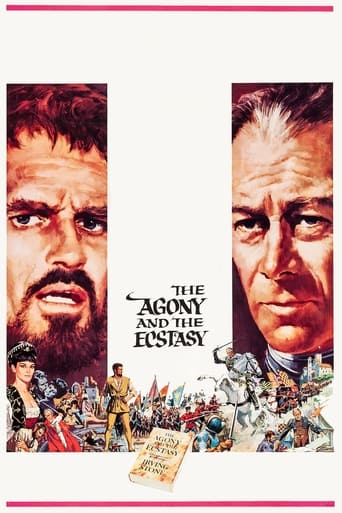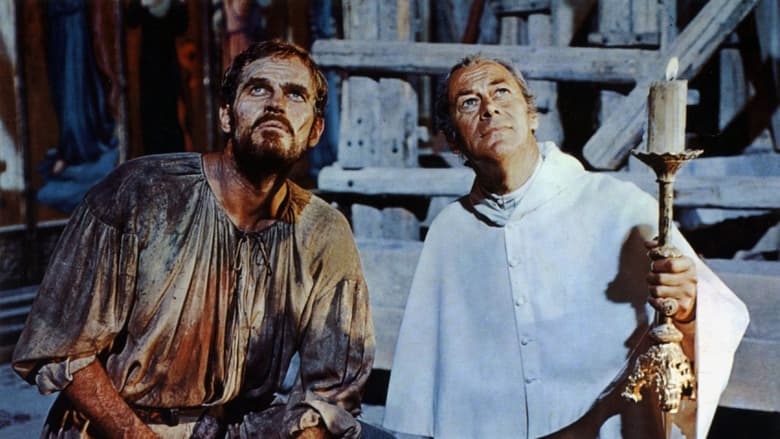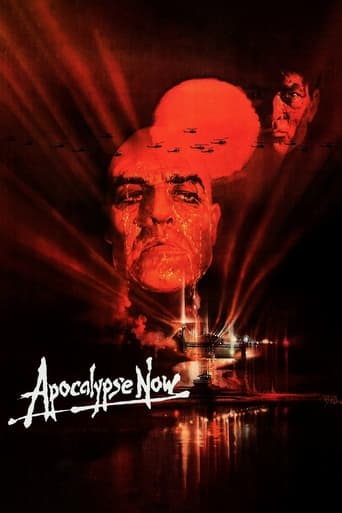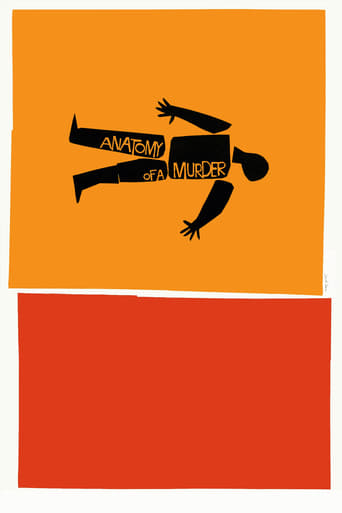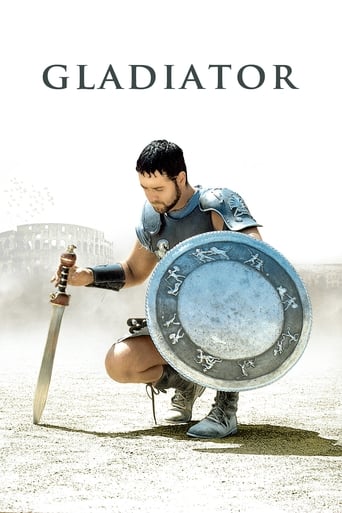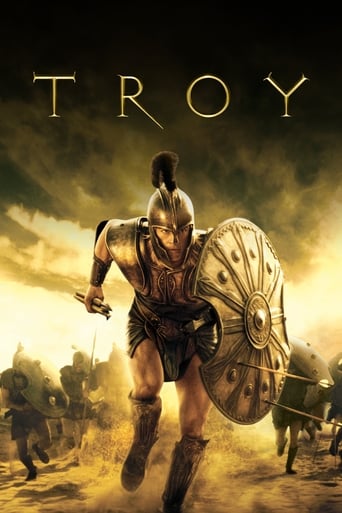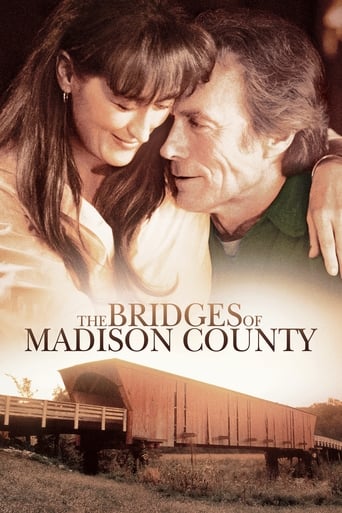The Agony and the Ecstasy (1965)
During the Italian Renaissance, Pope Julius II contracts the influential artist Michelangelo to sculpt 40 statues for his tomb. When the pope changes his mind and asks the sculptor to paint a mural in the Sistine Chapel, Michelangelo doubts his painting skills and abandons the project. Divine inspiration returns Michelangelo to the mural, but his artistic vision clashes with the pope's demanding personality and threatens the success of the historic painting.
Watch Trailer
Free Trial Channels
Cast



Similar titles
Reviews
What a waste of my time!!!
It is a performances centric movie
It is neither dumb nor smart enough to be fun, and spends way too much time with its boring human characters.
It's easily one of the freshest, sharpest and most enjoyable films of this year.
Already renowned as a master sculptor, Michelangelo is commanded by Pope Julius II to paint the ceiling of his Sistine Chapel, and he reluctantly accepts the commission. Based on Irving Stone's best-selling novel, "The Agony and the Ecstasy" is a thin retelling of the artist's creative struggle and his verbal sparring with the Pope. Carol Reed's lavish production is shamelessly padded with a documentary prologue about Michelangelo's sculpture, an intermission little more than an hour into the movie, exit music, and numerous atmospheric shots that add little but running time to the story. However, the padding and extras provided enough perceived value to warrant a reserved-seat roadshow presentation at higher ticket prices, which was a popular venue for prestige films in the 1950's and 1960's. Unfortunately, this obviously big-budget production exemplifies the old adage that the whole is less than the sum of its parts.Charlton Heston has a granite face and monumental physique that suggests one of Michelangelo's sculptures, and, while he has on-screen presence, his acting range falls short of the demanding role of a tortured artist. Rex Harrison, on the other hand, is outstanding as the warrior pope, a complex man balancing spiritual and worldly ambitions. Fresh from an Academy Award nomination for his Julius Caesar in "Cleopatra" and a second nomination and the Oscar for his Henry Higgins in "My Fair Lady," Harrison deserved a least a third nod for this film. The rest of the cast is adequate, although Diane Cilento, who does the best she can with a thankless role, is little more than a bone thrown to the female audience in what is essentially a male-centric drama. Michelangelo is among the world's most famous historical gay men, and, while Philip Dunne's screenplay alludes to the artist's sexuality, the script blurs the issue and sidesteps a direct confrontation; Cilento's ambiguous relationship with the artist was likely intended to throw off all but the most knowledgeable viewers.Aside from Harrison's performance, "The Agony and the Ecstasy" is worthy viewing as a visual feast. Fresh from Oscar-winning work on "Cleopatra," the Twentieth Century Fox design team of John DeCuir and Jack Martin Smith stunningly recreated the ecclesiastical glory of 16th century Rome. Among other Oscar winners for "Cleopatra" were Vittorio Nino Novarese, whose costumes glow in reds, crimsons, and golds; and Leon Shamroy, whose color cinematography gloriously captures the period detail. A fine score by Alex North, another veteran of "Cleopatra," further enhances the visuals. Carol Reed's adaptation of "The Agony and the Ecstasy" is eye, and some times ear, candy, especially for those interested in art history; the scenes that detail the creation of the Sistine Chapel ceiling are particularly fascinating. However, beyond the visuals and an award-worthy performance by Rex Harrison, the film is thin on drama and weak on historical accuracy.
Changing Taste in Popular Culture found this Movie at the End of the Epic Big Budget Historical/Biblical Extravaganzas and this was a Testament to the Volatile Times as it Lost Much Money and was a Critical and Box Office Mediocrity.That is not to say that is what the Film Represents, because it is a Magnificent Production with Elaborate Scenes, Exquisite Costuming, and Respectable Performances. The Story of Michelangelo's at First Reluctance and then Overwhelming Devotion to Painting the Ceiling of the Sistine Chapel and His Ongoing Battle of Words and Wits with Pope Julius II is Captivating Cinema.It is Virtually a Two Man Show and Much of it is in the Setting of the Development of the Four Year Long On Again Off Again Project that Ended in One of History's Most Iconic Artistic Achievements. It is Informative and Illustrious to Behold, the Process and Pain that it took to Endure the Creation of that Masterpiece. The Film is Long and Wordy but Never Fails to Capture the Essence of the Two Men and the Heart of the Matter is Unveiled.Never Overly Pious, as these Things tend to be, this is Essential Viewing for Art Students and Lovers and as a Film it is Well Done and Glorious to Watch.
Pope Julius (Harrison) has an enormous chapel and he wants the ceiling painted. Maybe pictures of the Apostles. He hires Michelangelo Buonarotti (Heston), a sculptor, to do the job. But Michelangelo is hesitant to take the job because he thinks of himself as a sculptor and is not a member of the International Guild of Sistine Chapel Ceiling Painters. But he's finally persuaded, although the Pope is always behind in his payments.The movie is all about Michelangelo's troubles with the Pope, with his own vision, and with his capacity for love. Diane Cilento, a Roman noblewoman, makes herself available to him but his love is only for his art. So he says. I'm not so sure historians are all agreed on that point but if it's true, it's a good example of what Freud would call "sublimation." Heston does a pretty good job of being a sloppy and contentious artist. Rex Harrison seems somehow misplaced as the Warrior Pope. He exudes elegance and wit but not a thirst for power. Rafael makes a few brief appearances as a handsome young man with a page boy haircut or whatever it is. Devotees of the Mutant Teenage Ninja Turtles may be surprised to find that there actually was such a man. The rest of the cast has a few well-known names but they have virtually nothing to do except say lines like, "If your Holiness permits, may I show you something?" There are lots of extras, some dubbed into English.Director Carol Reed had some some fine work over the past thirty years but the pace here is slow and deliberate, despite all the shouting and arguments. The undistinguished musical score veers from holiness to majesty and back again. Production design and set dressing are unusually well done, and wardrobe and make up are exceptional. Heston looks like a filthy bum. We never see him in full, blazing Renaissance panoply, or with that comely forelock he was given in "El Cyd." Instead he has the kind of haircut my barber, Francisco, gives to me. Someone has lifted Heston's hair, clump by clump, and taken a machete to it. Rome looks like we imagine Rome to have looked, not like a set at Cinecittà, except for the absence of horse manure on the streets. Let's not be offensive.Speaking of that, the only close up we see of Adam in The Creation is by candle light. Adam's dingle was small enough to begin with, but here it's kept in dark shadow so as not to offend the ladies in small towns. I have in my possession, somewhere, a post card from Rome sent to a lady in Fitchburg, Massachusetts, purchased for five cents from some local busker. The text runs thus. "Dear Helen. We visited museums today. Some of the statues are undraped. Love, Agatha." The date is 1902.I don't know for sure that the movie is all that historically accurate. Some of the dialog must have been invented, not that it matters much by itself. The problem is that the dialog has little cleverness and no sparkle at all. It's a long movie and rather dull at times. Yet, for all that, it's educational and should be seen by people who never heard of Michelangelo Buonarotti. That includes an awful lot of high school kids and some liberal arts majors.
The film is an epic grandeur feature of a interpersonal tug-of-war between the maestro Michelangelo and Pope Julius II.I cannot help being shell-shocked to see the reconstruction of the magnificent ceiling though recognizably most of which is the trickery of montage (not in the real the Sistine Chapel, the location was inside Cinecitta Italy instead), but bathing under the glamour and solemnness of the visual wonders, I am stunned to exude my admiration and awe!The two leads conspicuously stimulate a Moses versus Caesar confrontation, Charlton Heston seems to be more boorish than artistic to manifest a struggled Michelangelo, may God doesn't distinguish his people by their looks. The "agony and ecstasy" is watered down to an underwhelming stalemate thanks to Charlton's outlandish incarnation as the most eminent artist of that time. Rex Harrison, is by far and large worthy another Oscar nomination for his arresting devotedness, which is apt to impress the audience with a mind-blowing bi-polar characterization while good and evil coexist at the same time.The film was a grave box office fiasco when it came out in 1965, however, judging by my appraisement, its merits still can be appreciated by our generation (a well-balanced script, the haunting original score and all the props and settings). However, the film entirely skipped Michelangelo's sexual orientation and awkwardly ploys a portentous conversation between Michelangelo and his admirer Contessina de'Medici (a over-wise Diane Cilento), which unveiled its cowardliness and helplessness.My final remark is that as time goes by ruthlessly, art stands still and never fades away, so lucky enough cinema is yet a part of it.

